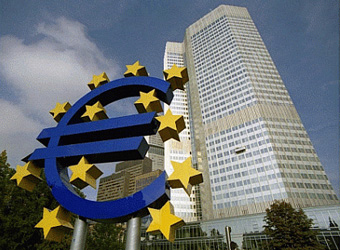The European Central Bank faces intense pressure to cut interest rates on Thursday but is unlikely to buckle, waiting instead to see whether a dive in inflation is sustained.
The 23-man Governing Council faces the most intense market scrutiny since it lowered rates to a record low of 0.5 percent in May, when some policymakers pushed hard for a bigger cut.
Some Council members wanted to cut rates again last month. Their case was bolstered a week ago by data showing a surprise slump in euro zone inflation to 0.7 percent in October, well below the ECB’s target of just under 2 percent.
But the ECB is unlikely to be jolted into a cut by one surprise inflation figure.
“It would probably be good for the ECB to see one more inflation number to assess whether the very low level is sustained,” said Nordea’s Anders Svendsen, one of a batch of economists to forecast a December cut after the inflation dive.
All but one of the 23 money-market traders polled by Reuters this week expected the ECB to remain on hold at Thursday’s meeting, pending a clearer view about where euro zone inflation is heading.
Prior to the meeting, three strains of thinking appeared to be running through the Council, people familiar with the internal debate said.
One group was content to keep open the option of another round of long-term loans to banks, another favored an interest rate cut, while a third was prepared to sit this one out.
“They are in a situation where they cannot do that much more on rates,” said Svendsen. “If they decide to add more liquidity to the market, that could be a good substitute for a rate cut.”
Political pressure in the run up to this week’s meeting is unlikely to sway the policy decision.
The ECB has faced calls from Italy’s finance minister and France’s industry minister to ease policy in response to strength in the euro, but the central bank cherishes its independence and will simply blot out the political noise.
DECEMBER OPTION
New ECB staff forecasts on growth and inflation due at the December meeting will give the Council members more information on which to act, should they wish to.
The ECB has to think carefully about if and when it wants to play the rate-cut card. After that only non-conventional tools will be left and those are significantly more difficult to agree on among the 23 Council members.
Adding to the ECB’s dilemma over how to support a fragile recovery is a fall in excess liquidity – cash beyond what lenders need to cover day-to-day operations – as banks repay 3-year ECB loans early before a health check next year.
These early repayments are expected to push interbank lending rates higher over time and the ECB is considering pumping more liquidity into the system to offset this development.
In a Reuters poll last week, 44 out 59 analysts surveyed said the ECB would inject more liquidity, probably early next year. It could do so, for example, by launching another long-term refinancing operation (LTRO).
A cut of the main refinancing rate to 0.25 percent could potentially also slow the pace of LTRO repayments, as lower interest costs make it more attractive for banks to hold on to the loans for longer and invest them in higher-yielding assets.
ECB chief Mario Draghi will use his post-rate meeting news conference to try to dispel concerns that October’s inflation drop raises the specter of deflation in the euro zone. The head of Italy’sbusiness lobby Confindustria said on Wednesday the country is in a worrying “situation of deflation”.
The ECB has already said it expects to keep its key rates “at present or lower levels for an extended period of time.”
“If they’ve got a genuine easing bias, if they don’t cut now or hint a cut is nailed on next month it’s going to be very hard to convince people they are ever going to,” said Richard Barwell at RBS, one of a minority of economists expecting a rate cut on Thursday.
Source: Reuters



